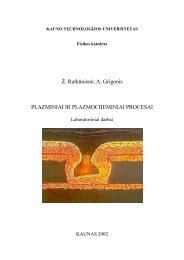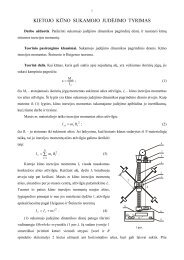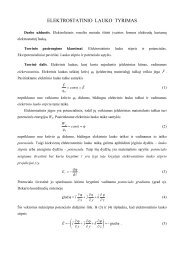PROCEEDINGS OF THE 7 INTERNATIONAL ... - Fizika
PROCEEDINGS OF THE 7 INTERNATIONAL ... - Fizika
PROCEEDINGS OF THE 7 INTERNATIONAL ... - Fizika
You also want an ePaper? Increase the reach of your titles
YUMPU automatically turns print PDFs into web optimized ePapers that Google loves.
MEDICAL PHYSICS IN <strong>THE</strong> BALTIC STATES 7 (2009)<br />
Proceedings of International Conference “Medical Physics 2009”<br />
8 - 10 October 2009, Kaunas, Lithuania<br />
DIAGNOSTICS <strong>OF</strong> CANCEROUS PROSTATE TISSUE BY MEANS <strong>OF</strong><br />
INFRARED SPECTROSCOPICAL IMAGING<br />
Daiva LEŠČIŪTĖ*, Valdas ŠABLINSKAS*, Valdemaras ALEKSA*, Arūnas MARŠALKA*, Feliksas<br />
JANKEVIČIUS**<br />
*Dept. of General Physics and Spectroscopy, Faculty of Physics, Vilnius University; ** Dept. of Physiology,<br />
Biochemistry and Laboratory Medicine, Faculty of Medicine, Vilnius University; ***Centre of Urology, Vilniaus<br />
University Hospital Santariskių klinikos, Faculty of Medicine, Vilnius University<br />
Abstract: Method of Fourier transform infrared microscopy (FTIR-MC) for the first time is applied for studies of<br />
prostate cancerous tissue. The chemical images are obtained by combining mapping technique with imaging with focal<br />
plane array (FPA) MCT detector. It is shown that ratio of intensity of amide I and amide II spectral absorption bands<br />
can be used for distinguishing cancerous tissue from healthy one. By combining infrared spectral images with optical<br />
ones it is shown that infrared imaging is preferable method for defining edges of cancerous tissue of prostate samples<br />
compared to the method of conventional histological imaging. It is shown that infrared images allow to define such<br />
edges with 10 microns lateral resolution.<br />
Keywords: FTIR-MC, FPA detector, prostate, cancer<br />
1. Introduction<br />
Modern infrared spectroscopy combined with infrared<br />
microscopy allows investigate features of samples in<br />
micrometric scale. Just recently this method was<br />
started to be applied for studies of biological tissues.<br />
Determination of spatial distribution of different<br />
chemical components in biological tissues is even<br />
possible by using this method. Sensitivity of the<br />
method enables to identify tumors even in very early<br />
stage of this disease.<br />
Early diagnosis of the tumor is very important for its<br />
prevention or successful curing of the patient. Tumor<br />
formation can be caused by very different reasons such<br />
as some genetic miss functioning or some cancerous<br />
substances which can present in our surrounding or can<br />
be taken in to the body by breathing or with food.<br />
Biochemical changes in various tumors usually are<br />
very different [1]. FTIR method supplies very useful<br />
information about molecular structure of biological<br />
tissue. Chemical information obtained by means of<br />
infrared spectroscopical microscopy is molecular level<br />
information taken from volume of the sample sized to<br />
micrometric scale [2].<br />
2.1 Focal plane array detector<br />
For any optical imaging some multichannel detector is<br />
needed. Focal plane Mercury Cadmium Telurate (FPA<br />
16<br />
MCT) detector is detector of choice in case of infrared<br />
imaging. A FPA MCT detector consists from many small<br />
single detectors sized to 6 - 10 μm 2 . Every single detector<br />
in the array collects the spectral information from<br />
different parts of the sample. Set of spectra obtained by<br />
different single detectors of the array can be used for<br />
constructing of infrared image of the sample in desired<br />
spectral window located in infrared spectral region from<br />
500 to 4000 cm -1 . Such image is considered to be<br />
chemical image of the sample when the spectral windows<br />
coincide with spectral band specific to one of chemical<br />
components of the sample [3]. At present stage of<br />
technology the FPA MCT detectors consist from 4096<br />
single detectors, which form 64 × 64 matrix. In such a<br />
way 4096 spectra are captured at a time. Infrared imaging<br />
becomes rather fast by using such a detector. Sensitivity<br />
is another feature of this technology. Lateral resolution<br />
obtained with use of such detectors can be achieved as<br />
high as size of biological cells. Due to this fact this<br />
technology is preferable compare to other imaging<br />
technologies which are in use in medical laboratories or<br />
operational rooms. It is notable, that in order to extract<br />
chemical information from infrared microscopical images<br />
some statistical analysis of the images should be applied,<br />
including principal component analysis (PCA) and some<br />
other unsupervised or supervised statistical methods.<br />
Basically, processing of spectral information from the<br />
FPA detector is rather complicated. A set of<br />
interferograms is primary spectral information, obtained








